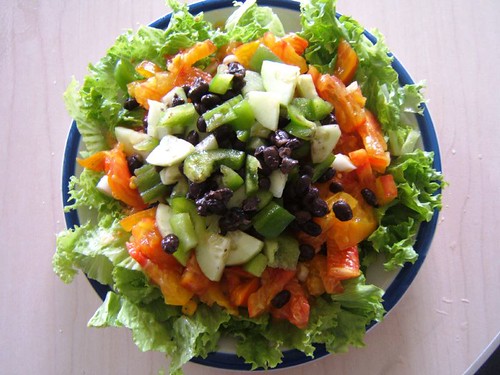I mixed up this delicious summer salsa themed salad the other day and it did not disappoint:

In it, we have:
~2 c. romaine lettuce
1 heirloom tomato, diced
1/2 green bell pepper, diced
1/2 cucumber, peeled and sliced
2 tbsp Trader Joe's corn salsa
1/2 c. cooked black beans
handful chopped scallions
a few sprigs of cilantro
While we're on the topic of salad, I'm also going to mention one of my weird food things: I don't do salad dressing. Not for any particular health reason, but because I never liked it as a kid. And then I found out that most dressing wasn't that good for you anyway, so I never bothered to seriously acquire the habit. I do make occasional exceptions for a nice oil and balsamic vinegar, but in general I prefer my salad naked.
A lot of people are really surprised to hear about my no-dressing preferences, insisting that salad by itself tastes bland or even gross. My answer to that is that these people are clearly eating the wrong kind of salad. If you chop up a head of iceberg lettuce and call it a day, then yes, it is bland, and yes, dressing will probably improve it. The key to a good salad that is not dependent on slatherings of ranch is to have lots of interesting ingredients. I have a couple of salad guidelines that I like to try and follow:
1. NO ICEBERG LETTUCE. Sorry, this one is super important, so I had to go with the all caps. My top pick for greens would be spinach, as it has the best vitamin and mineral content. In case you weren't aware, spinach is a great source of iron for vegetarians and vegans. Unfortunately, it is not as great a source of calcium as some folks would have you believe, despite what the nutrition label may say. If you can't spring for spinach, at least get some more interesting varieties of lettuce: romaine, bibb, red, etc.
2. Have lots of non-greens components. I like to try to have at least three non-greens vegetables in my salads. Some good options include: tomatoes, peppers, cucumbers, sprouts, carrots (especially attractive if you take the time to grate them), artichoke hearts, beets. Also, if you have any cooked vegetables leftover from dinner the night before, chop them up and toss on your salad as well.
3. Make your salad a meal. Vegetables are good for you, but they don't make a very filling meal by themselves. I like to make my salads a full meal by adding some sort of bean and/or grain into the mix. Cook a large batch of beans in your crockpot on the weekend and then toss a handful onto your salads throughout the week. My favorites are black beans and chickpeas, but red and white beans can also taste good. For grains, I like to add a little couscous, whole wheat pasta, or quinoa (which I know is not technically a grain but in my kitchen it gets treated like one).
4. Dress up your salad with non-dressing. While I hate traditional dressing, I do like to add things like a generous dollop of hummus or a few chopped nuts to my salad. They add a lot of flavor and much more nutrition than anything you'll find in a bottle at the grocery store.
It's really very simple to make a delicious, healthy, and interesting salad. Now put down that dressing bottle and head of iceberg and get to work on yours!


This looks so delicious and refreshing!
ReplyDelete